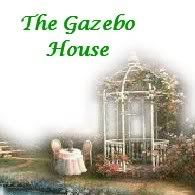 On the second Sunday of every month,
On the second Sunday of every month,Beth, author of the fabulous blog
Gypsy Fish Journal
hosts "Silver Sunday".

This is the first time I've joined the party!
I wanted to share my Old Sheffield silver tea & coffee service
that sits on the buffet in the dining room.
 There are two pitchers behind the front ones.
There are two pitchers behind the front ones.
I should have moved them apart before taking so many photos.
I wanted to share my Old Sheffield silver tea & coffee service
that sits on the buffet in the dining room.
 There are two pitchers behind the front ones.
There are two pitchers behind the front ones.I should have moved them apart before taking so many photos.
 I'm SO glad we moved this large mirror to this spot.
I'm SO glad we moved this large mirror to this spot.It really opens up the whole space but I have mixed
emotions about what toll it took.
You can read about that adventure here.
It was the very next day that hubby had his heart attack.
I'm sure the lifting of that heavy thing contributed to it!!!

I find it difficult to photograph such shiny things.
I tried in many different lights & times of day.
I tried with the early morning sunshine streaming in on it.I tried up close without a flash during the middle of the day.
I tried in many different lights & times of day.
I tried with the early morning sunshine streaming in on it.I tried up close without a flash during the middle of the day.
 Even the low light of evening...that glare is from the arched window...my flash was off.
Even the low light of evening...that glare is from the arched window...my flash was off.I've searched for information about Old Sheffield, specifically
"silver on copper" as mine is marked & would like
to share this article from a magazine on the subject.
( Originally Published 1963 )
Almost as valuable as solid silver are old pieces of Sheffield plated silver. Sheffield, England, has been a famous center for metal and cutlery since the fourteenth century. The special process named after the town dates back to 1742 when Thomas Boulsover, a cutler, found that silver and copper could be fused by heating, then rolled out into a thin, smooth plate that could be worked as could solid silver. Old Sheffield plate is made from two sheets of silver bonded to one of copper, with the edges bound in silver. The sheets of silver in Sheffield plate are thicker than the covering of silver deposited by electrolysis on modern plated silver.
Articles of Sheffield plate were displayed proudly on sideboards, mantelpieces, and dining tables. The same pieces and the same styles that were used for silver also were produced in Sheffield plate. Candlesticks and candelabra, teapots, tea and coffee services, trays, serving dishes, and tureens were the principal large pieces. Baskets for cake and fruit, cruet stands, and epergnes were handsome and now owned by far more people than when they were made only of silver. Inkstands, small boxes for tobacco and snuff, buckles and buttons also were used and worn proudly.
Gadrooned edges were as general on Sheffield plate as on silver. Shells and three feathers were common decorative motifs and an initial or a monogram was usual. A few firms are said to have produced quite distinctive pieces that borrowed little from silver ones in design or decoration. All firms were noted for their good workmanship.
The making of Sheffield plate was a thriving industry for about 100 years. Some small amount was made in America, but most of the early Sheffield plate to be found in this country was imported. In the early 1800's, the fusing of silver on copper spread to France, Germany, and elsewhere in central Europe as well as Russia, but the quality is not considered to be as high as that of the Sheffield plate made in England. It's not unusual to find candlesticks or other household pieces of European plate in this country. However, the silver-on-copper ware made in Europe during the nineteenth century seldom seems to be stamped with maker's marks-certainly I have never seen any marks on pieces made in Germany.
During a ten-year period from the 1770's into the 1780's, London silversmiths succeeded in preventing firms that made Sheffield plate from marking their ware. Before the early 1770's and after 1784, identification marks similar to those stamped on silver were used, Some pieces also had the word Sheffield stamped above the hallmark.
In the 1840's, the making of Sheffield plate began to die out. It's interesting that within thirty years or so, in England, antique collectors began acquiring pieces of Sheffield plate. In 1911, action was taken and it was established in court in Sheffield that the term "Sheffield Plate" could be applied only to pieces made by the method of fusing practiced in the eighteenth and early nineteenth centuries.
Antique Sheffield plate probably represents a lost art. These pieces wear surprisingly well. However, articles with thin spots where the silver has worn down or been cut by repeated use of a carving knife so that the red copper base is exposed are called "bloody." Such pieces bring a lower price than one with its silver coatings unblemished.
Sheffield plate was less expensive than solid silver. However, it was not as much cheaper as pressed glass was in comparison to cut glass. Therefore, when the newer process of electroplating was developed in the 1840's, it displaced the Sheffield plating method in just a few years. Electroplating proved to be a far cheaper process of covering a base metal with silver (then, as now, sterling cost about three times as much as the same piece in plated silver.)
Only an article that is 92.5 per cent pure silver could be marked "Sterling." Plated- silver, however, was made in several grades. Currently, plated silver is either standard or first quality, the latter term meaning that the pieces have a heavier coating of silver than standard ones. Quite an amount of nineteenth-century plated silver is stamped "Triple" or "Quadruple" plate. Such pieces, if they have been exposed, may be charcoal-colored and take a good deal of polishing to restore their silver tone. Of course, even triple or quadruple-plated pieces that were used daily for a good many years will have spots where the silver coating has worn down to the base metal. It's worth the hard polishing that a darkened piece of plated silver needs to see just how it will look. Many of the triple- and quadruple-plated pieces are in surprisingly good condition and need only minimum polishing to look their best. "
I try to be very careful when polishing my set,
by not rubbing too hard & never soaking it harsh cleaners.
Those can get into hollow areas & eat away at the metal over time.
Thanks, Beth, for letting me share my pretty shiny objects
& thanks for visiting the Gazebo House today, too.
Be sure to stop by Beth's blog to see the other silver items, too.
fondly,

























































Hi! I am so glad you came to visit my blog and leave a comment! It gave me a chance to come over and visit you.
ReplyDeleteYour blog is delightful. I love your silver set and the mirror looks great there. I am off to ready some more of your pasts post. I hope you stop back in for a visit again soon.
Penny
That set is absolutely lovely! I think your mirror looks wonderful there, but I understand the emotions tied to it. I have a shirt that I was wearing when I had a miscarriage. I had to give it away. I couldn't stand to look at it!
ReplyDeleteI love the pictures you took of your tea service. All the angles and lights are just beautiful. Isn't it amazing how different it looks in the morning light and evening light? Just gorgeous!
Rett, your tea and coffee set is absolutely stunning. Such a beautifully intricate pattern. Love it. I really love the reflection in the mirror too. That gorgeous arched window is to die for. Your home is stunning. Hugs, Marty
ReplyDeleteThank you for stopping by my blog!
ReplyDeleteAfter seeing your SHINEY silver, I feel so dirty displaying my tarnished pieces, but I have to admit... I LOVE IT TARNISHED!
Your tea set is gorgeous and I agree- those suckers are HEAVY! Your poor hubby, I hope he is on the mend!
Oh, my goodness!
ReplyDeleteHow beautiful!
Thank you for sharing!
Leticia
Hi Rett!
ReplyDeleteHappy Sunday to you. God bless you and may you have a sweet week!
I could kick myself...years ago there was a gorgeous Tea Service Set that I should have put on Lay Away. I didn't...of course some smart person purchased this.
It was gorgeous and I would love to have had it.
Hope to have one of my own someday soon! They really are a beautiful addition to one's estate.
Happy Eloquent Tea Time,
d
I'd sigh with pleasure every time I walked by that scene, if I were you. The silver, the mirror, the reflected outside view - just beautiful!
ReplyDeleteYour Sheffield set is stunning, Rett. I love Sheffield. I was drooling over them when we were in England. I also like how you have so many pieces on that beautiful tray. Thanks for the info about old Sheffield plated silver...Christine
ReplyDeleteYour service is stunning. I love all of your photos but the one that "sparkles" with little bouncing beams of light off the pieces is exquisite. You are a great photographer.
ReplyDeleteThat is a beautiful service, Rett! I really love your samovar. That is such a neat piece, and you don't always find them with a silver service. Generally, they come separately, so that is a real find to have a whole set like that. NEAT!
ReplyDeleteIt is hard to photograph silver, but oh, how I love to see it shine!
Thanks for all the helpful info, too!
XO,
Sheila :-)
Hi Rett! Oh, what a lovely silver tea service! It looks like it's in the perfect spot too.
ReplyDeleteSorry about your husband's heart attack. Hope he's doing better now.
The reflection of you home in the mirror is just glorious!
Be a sweetie
Shelia ;)
Oh my goodness, I am SOOO jealous!!! I LOVE Sheffield Silver, and what a beautiful example you have!! It is just gorgeous. Breathtaking, and your home is gorgeous too!!
ReplyDeleteI know you love your tea and coffee set, but I LOVE the view that gorgeous mirror reflects. What a sight! I'm so glad your took a picture from that angle. I had to look at it almost forever to see everything.
ReplyDeleteThe shine is hard to keep up, that's why I've gone over to the 'dark side' tarnished that is. But yes it is hard when what you are trying to photograph something and you can't get an angle without yourself or something you'd rather not share, say a pile of dirty dishes. So thanks for also sharing your beautiful room in the reflection of your large mirror.
ReplyDeleteHope hubby is doing well. Susanne.
Hi Rett, nice to meet you :) Your Sheffield set is royal-looking...so beautiful. Doncha just hate it when husbands go off and do things like that? (have heart attacks). I trust yours is doing all right.
ReplyDeleteYour grand-daughter is a dream in her pillowcase? dress and in the picture holding the gorgeous bouquet of pink peonies(which I'm crazy for).
Thanks for stopping by :)
Rett, this was a lovely post. Your tea service is beautiful, as is your home. The mirror looks perfect in that spot and I'm really impressed with your talent with a camera. I hope you are having a wonderful day. Blessings...Mary
ReplyDeleteOh my, Rett! I think that is the prettiest silver service I have ever seen! I love the way you photographed it at different times of day! I hope your hubby is doing well now! Happy week!...hugs...Debbie
ReplyDeleteYour silver service is lvoely and absolutely stunning. Enjoyed the history of Sheffield.
ReplyDeleteYour photos were fantastic - loved seeing the view through the mirroe also..
Hope your hubby is doing well.
Rett,
ReplyDeleteyour silver tea and coffee set is a real treasure. So decorative and outstanding with the samowar. And in front of the mirror is just the best place to display it. Thank you for this valuable information about Sheffield Silver Plate. I knew something about it but now I learned a lot, too. That is was I love on blogging. To learn and see wonderful things.
Greetings, Johanna
Oh that is pretty! I love the shot where you can see the Gazebo!
ReplyDeleteI forgot all about Silver Sunday. I did it once in the winter.
Must mark it down! So many memes!
Beautiful set!!
What beautiful silver you have! Rett, to remove your cutest blog on the block background...just go to design and scan down all the gadgets you have on your sidebar or at the bottom of your blog. You should see one that says "html/javascript. Click on edit, read through the code and see if you see the words, Cutest Blog on the Block. If you do, that should be your background. Then you just click remove and save. Click on "edit" on all the html/javascripts you see down your sidebar to make sure you which one is the one that's the background code. Once you find the one that says Cutest Blog on the Block...you will know you've found your blog background. I don't think you've added anything else from there...most likely. Lily Puff Designs has A LOT of backgrounds that work with Minima Stretch template if you decide you want something besides all white. Once you remove the gadget from CBOTB that is giving you the damask background, your blog background will just be all white like you see on mine.
ReplyDeleteHope this helps!
Susan
What a nice post of your gorgeous tea service! The photography is wonderful! I enjoyed seeing some of your beautiful home in the mirror reflection! That's awful about the weight of it causing the heart attack!! I keep telling my husband we should hire someone to do things like that (at our age!) Mr. Macho won't hear of it! LOL!
ReplyDeleteKatherine
Rhett, your Old Sheffield silver tea & coffee service is exquisite! It looks so wonderful reflected in your beautiful mirror, and the other reflections in the mirror are beautiful as well.
ReplyDeleteI'm sorry to hear your husband had a heart attack and I do hope he is doing well now.
Hey Girl~ ~Your silver set is beautiful! I just picked up a pretty silver pitcher at auction but I would love to have a whole set like yours!
ReplyDelete~ ~Ahrisha~ ~
My, what beautiful silver you have, Rett! It looks spectacular where you have it displayed. I love the reflected image of your interiors, the lake, and your wonderful gazebo. Yes, silver is tough to photograph, but you did it! Gorgeous post!
ReplyDeleteWarmest regards,
Bill
Rett: I just love your post! You're a wealth of informantion...I'm so glad I popped over, love your blog. Thanks so much for stopping by and joining the party...see you next month.
ReplyDelete{{hugs}}
Beth
Your silver service is gorgeous, Rett, and you have such a beautiful spot to display it. I've never been successful in getting what I would call good photos. I know there's a trick to it, I just haven't found it.
ReplyDeleteYour info about Sheffield plate is so interesting. I never mind polishing my silver because I'm just so grateful to have it. It's a labor of love.